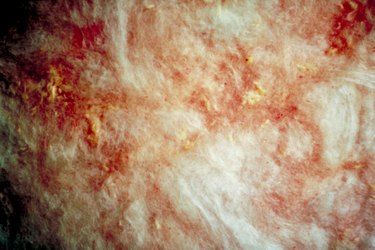
Vapor barriers are sheets of plastic or other material placed on one side of insulation sheets. This barrier is meant to keep moisture from getting to the insulation in the walls and ceilings, and it is required by building codes when insulating most houses. In any case, the vapor barrier must point to the warm side.
Condensation
Video of the Day
In walls and ceilings, there is the risk of condensation building up within the inside. This is especially true in tightly fitted walls where little air travels. The warmer air on one outer side of the wall causes water to build up along the colder inner side. The moisture will get the insulation wet and reduce its effectiveness. It can also cause mold, rot and other problems in the wall. The right barrier will block the moisture from reaching the insulation.
Video of the Day
Direction
The placement of the vapor barrier depends largely on the climate where your house is. In warm climates, the barrier should point to the outside of the house, blocking the vapor from the humid outside air that may seep into the walls or ceilings. In cold climates, the opposite is true. The air is usually warmer inside the house, so condensation can build up from air entering the wall from the inside. The vapor barrier should point toward the room in this case.
Compromises
Regions where climates can noticeably change with the season can be a problem for insulation. You may need to find a compromise. If you have a greater risk of extreme cold over extreme heat, install the vapor barrier on the inside. If your area has a greater risk of extreme heat, you may need to replace the insulation with a stronger material. Install an aluminum, masonry or glass barrier within the wall that can serve as insulation while withstanding occasional dampness.
Vapor Barrier Paint
Older homes are not as dependent on vapor barriers, as they are not as airtight and the air flowing through keeps it dry within the walls. In many of those cases, vapor barrier paint woks better than installing sheeting. Instead of pulling away the insulation sheets to slip in the barriers, apply at least one thick coat -- maybe two -- to the insulation. The application can vary, so read all instructions on your specific brand of paint.